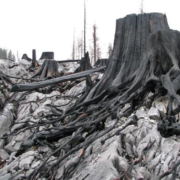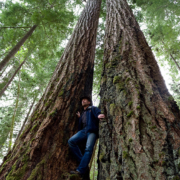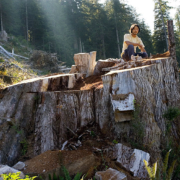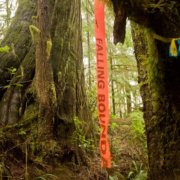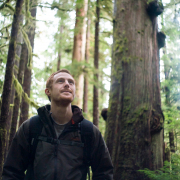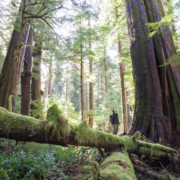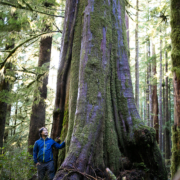Photography is a way of feeling, of touching, of loving. What you have caught on film is captured forever. It remembers little things, long after you have forgotten everything. It doesn’t always have to be people or objects. I once heard a quote by Robert Adams that reads “No place is boring, if you’ve had a good night’s sleep and have a pocket full of unexposed film”. Quickly after meeting Canadian based landscape photographer TJ Watt I realized that this quote was written about him.
TJ Watt is a professional photographer living in the city of Victoria on Vancouver Island, BC. Born and raised in the rural town of Metchosin, he carries with him a strong passion for the outdoors, the environment, and life itself. TJ combines his personable nature, physical endurance, and strong knowledge of the natural world to cover a wide variety of important social and environmental issues. Whether it involves forging rough rivers, hiking through mountainside clear cuts, or hanging 100ft off the ground from the canopy of an old-growth tree, TJ brings back solid images that tell a compelling story. TJ’s past work is quite diverse. He has worked on a number of interesting and imporatnt projects for various ENGO’s such as the Western Canada Wilderness Committee, Sierra Club BC, and Spectral Q. His images have been published in the Times Colonist, Vancouver Sun, Victoria Daily News, Granville Magazine, Monday Magazine, JPG Magazine, Color Magazine, SBC Magazine, Concrete Wave, WCWC calendars and newsletters, and a variety of online media.
Daniel: Tell me about yourself, where are you from, what have you been up, where did you grow up?
TJ: My name is TJ Watt, I am 2wenty 5ive years old, and I’ve been fortunate enough to grow up in the enchanted rural town of Metchosin, BC on Vancouver Island (Canada). I’ve lived here my whole life and would love to continue to do so either in a house or in the bush if I have to! As of late my involvement in the environmental issues facing BC’s forests has expanded through co-founding the newly formed Ancient Forest Alliance! (www.ancientforestalliance.org). We’re working to protect the remaining endangered old-growth forest ecosystems in southern British Columbia and ensuring sustainable logging practices take place in second-growth forests. I am also an avid hunter of big trees and like peanut butter and cucumber sandwiches.
Daniel: When did photography become more then a hobby of yours?
TJ: It’s been a slowly evolving process I guess that started with saving up points on a gas station card to buy disposable cameras to shoot with. I was drawn right away to photographing nature, initially in a more abstract way, which overtime I have combined with my passion and concern for our natural environment. I’m not sure there was a specific transition point, just little changes here and there.
Daniel: Canada seems to have some amazing natural places, where is your favorite spot to take photographs?
TJ: Yes! The outdoors here is world class, especially in British Columbia with huge snowy mountains, long sandy beaches, and 1000+ year old trees growing over 50ft around! On the island we have the largest living examples of Red Cedar, Sitka Spruce, and Douglas Fir trees in Canada! The Red Creek Fir being the largest of its kind in the world! So as far as a favorite place goes, that is tough. It’s a close call between a pristine and virtually un-explored old-growth forest with giant monster trees and the top of a mountain with a wide expansive view at sunset.
Daniel: You do a lot of nature photography, do you go out by yourself?
TJ: Yes, I find myself alone much of the time. There are probably a few reasons for that. For practical reasons, I find it much simpler being able to move at the pace I like and take whichever route I want to, while also being able to stop for long periods of time for a shot without feeling like you’re holding anyone up. Another big reason though is I truly enjoy quiet solitude, especially when surrounded by lush forests and peaceful wildlife. There is nothing quite as healing as time spent wandering the woods alone.
Daniel: I know Vancouver Island has quite a lot of bears.. Have you ever had an encounter with a Grizzly bear? Have you ever thought this might happen, are you afraid – and what do you do to avoid this (e.g. gear equipment)?
TJ: While it is true there are a lot of black bears on the Island, Grizzly Bears actually haven’t made it here other than the odd one so they’re of no concern. Black Bears are actually much more a passive creature than you might expect. You really don’t stand much of a chance of having bear bother you unless you tie a steak’n’apple pie to yourself and then go smack one with a stick until it chases you. We have wolves and cougars as well but again, they’re much more likely to run away from you then come after you if you’re even lucky enough to see one. You should still be smart about things though like never camp in remote areas with food in your tent, never try and pet a bears babies, don’t try and ride a cougar like a wild horse, etc. As far as protection goes, I do carry a knife on my side for general safety and sometimes keep bear spray with me but I have yet to have to use either so far.
Daniel: What is it like being in the wild by yourself with just a camera? And how often do you travel?
TJ: Being alone in the wild, as I mentioned before, is the most peaceful and rejuvenating thing. It’s very humbling and helps to put life’s dramas in into a more leveled perspective. It also forces you to be much more aware of your surroundings and what is happening at each moment in time. There is no listening to your I-Pod while texting on your Blackberry. Your eyes are much more open, ears tuned into each sound, and steps more thoughtfully placed. It brings out much more primal movements and feelings in you including natural fears. It’s a bit of rush in a way to have the sense that the playing field is flipped and you are no longer in your usual territory anymore.
Daniel: Tell me about the SOS for World’s Whales, how did you get involved in this? What is it all about?
TJ: The image of the Orca whale was created by artist John Quigley of Spectral Q productions. He was in the middle of creating various whale images along the west coast from Baja, Mexico all the way to Alaska. The focus was on the fact that there is still a large threat to the world’s whales though most people think they are fully protected. To create the image he arranged over 500 school children into the shape on the ground and then we shot it from a helicopter for perspective. I really lucked out in getting the chance to shoot this actually. At the time, I was working on my portfolio for photo school and got word through a friend that he was going to be creating this piece so I phoned him up in Los Angeles and asked if he had a photographer already. He didn’t and decided to give me the chance to take the shots! It was quite the experience shooting out the open door from 1000ft in the air. We could have no loose articles on us whatsoever as the pilot said they could get sucked out the opening, go into the rear rotor, and we would all crash to the ground and go bang.
Daniel: If you could choose – what is your dream place to go to solo with a camera?
TJ: Hmmm… into space! If I could float around in a little clear glass bubble and photograph the giant nebulas, star clusters, and galaxies of this totally unbelievable universe that would be the most mind boggling thing in the world. Or, I guess out of the world.
Daniel: Share with us a good photography quote
TJ: “Say Trees!” oh….not funny.
See TJ’s photos at the Bloginity.com page with this interview or his own site www.utopiaphoto.ca.

